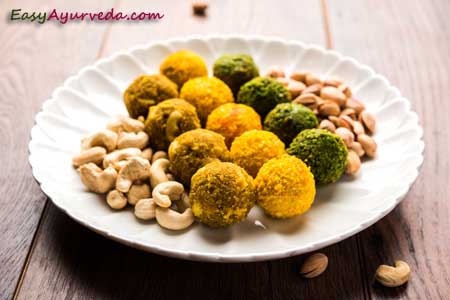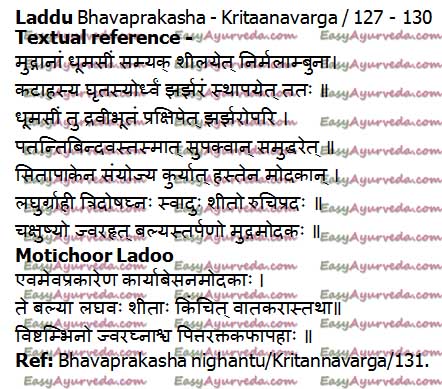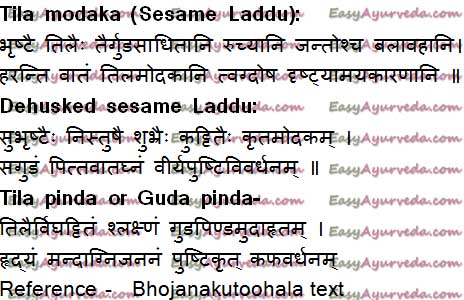Boondi Laddo, Motichoor Ladoo, Til Ke Laddu Method, Ayurvedic Benefits

Article by Dr MS Krishnamurthy MD (Ayu), PhD.
Table of Contents
Introduction
The only truth in the famous Chota Bheem cartoon serial is that, the Laddu is definitely an instant energizer. Laddu is a very famous sweet dish. It is offered as Prasadam in several temples. Laddu is believed to be favorite to Lord Ganesha. Tirupati Laddu is special of its kind due to its size, taste and standardized contents.
Including children, people of all the age group like varieties of Laddus. Even though newer sweets have been occupied the shelves of the sweet stalls, the people who have taken the taste will never deviate from the original taste of the Laddu and its liking.
Read related: Buy Edible gum laddu for after delivery care of the mother
Classical reference

Classical Reference: Bhavaprakasha nighantu – Kritaanavarga / 127 – 130
Classical preparation
How is classical Boondi Laddu?
Green gram flour is mixed with water and thicker consistency is made on proper maceration. In a big vessel ghee is taken and warmed. A mesh is taken and the previous kept green gram mixture is poured and gradually filtered over the boiling ghee. This forms the round shaped multiple small balls. On proper cooking it is taken out of ghee and added to the syrup. On proper soaking it is taken out and Laddus are made. This is called Boondi Laddu.
Qualities, actions
Qualities: Light, absorbant, sweet, tasty and cold.
Action: Balances Tridosha, good for eyes, pacifies the fever (caused due to exhaustion), energizer, nutritive and nourishing.
Application
As it is a nutritive and nourishing, it is advised to those who want to gain weight. Also, as it is very sweet and rich with fat, it is better to avoid in obese, cardiac patients and diabetic patients.

Very unique action is mentioned that the sweet is good for eyes (netrya). So on proper evaluation this can be adopted in dietetics, especially in eye diseases caused during old age.
As it is light for digestion, coolant and absorbant, in post fever debility this can be recommended.
Motichoor or Besan Ladoo is also a similar preparation where instead of green gram flour, yellow gram flour (Besan) is used to prepare the Laddu.
Ref: Bhavaprakasha nighantu/Kritannavarga/131.
Such a Laddu – Motichoor is light and cold in nature. It is also an energizer, Vata aggravating, leading to blockage of the channels etc. But appreciated as antipyretic. It is mentioned in the treatment of Pitta – Rakta and Kapha dosha aggravated conditions.
As per the basic ingredients used, the quality of the product also changes. However, the sweets like Laddus are quite energizers and nutritive in nature.
All the below references are cited in Bhojanakutoohala text of Shri Raghunatha soori.
Sesame laddu
Sesame Laddu (Tila modaka):
Here, the black sesame seeds are taken and fried a little. This is mixed with jaggery and pounded well to make into bolus of required size.
Instead of mixing, some prefer to add the sesame seeds to the liquefied jaggery and heating is continued till it is semisolid or thicker in consistency. Later, on self cooling or lukewarm it is rolled into bolus. On complete cooling this becomes hard and brittle.
Qualities
This Tila modaka is appetizer and tasty, energizer, and balances vata.
But excess intake or prolong usage may cause skin diseases and may decrease the visual acuity.
Read – Sesame and Sesame Oil Benefits – Total Ayurveda Details

Dehusked sesame Laddu
Sesame seeds are fried a little and dehusked. This is made into by the earlier explained method.
This Laddu is balances vata and pitta, aphrodisiac, and instant energizer.
Tila pinda or Guda pinda
Another similar preparation is termed as Tila panda or Guda panda. Here, without frying (with husk) the sesame seeds firstly made into fine powder. Then it is pounded with jaggery or cooked along with jaggery, so as to obtain the hard mass sufficient enough to roll into bolus (laddu).
This is said to be good for heart and nutritive. But texts give a cautious note that it may cause indigestion and aggravate Kapha dosha if taken excessively.
Same ingredients; but, different processes.. produces different actions!
Click to consult Dr MS Krishnamurthy MD(Ayu), PhD.








